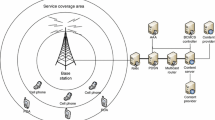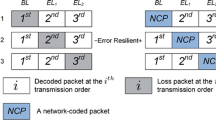Abstract
The cdma2000 1xEV-DO mobile communication system provides broadcast and multicast services (BCMCS) to meet an increasing demand for multimedia data services. But the servicing of video streams over a BCMCS network faces a challenge from the unreliable and error-prone nature of the radio channel. BCMCS uses Reed-Solomon coding integrated with the MAC protocol for error recovery. We show that this is not effective for mobiles moving at the edge of service area, where the channel condition is bad, resulting in significantly lower video quality. To improve the playback quality of an MPEG-4 FGS (fine granularity scalability) video stream, we propose a hybrid error recovery scheme incorporating a packet scheduler, which uses slots saved by reducing the Reed-Solomon coding overhead. Packets to be retransmitted are prioritized by a utility function which reduces the packet error-rate in the application layer within a fixed retransmission budget by considering of the map of the error control block at each mobile node. Our error recovery scheme also uses the characteristics of MPEG-4 FGS to improve the video quality even for a slow-moving mobile which is experiencing a high error-rate in the physical channel because of error bursts.
Similar content being viewed by others
References
J. Wang, R. Sinnarajaj, T. Chen, Y. Wei, E. Tiedemann, and QUALCOMM, Broadcast and multicast services in cdma2000, IEEE Communications Magazine 42(2) (February 2004) 76–82.
3GPP2, X.P0019 v 0.1.3, Broadcast-Multicast Services (BCMCS) Framework Draft Document (August 2003).
P. Agashe, R. Rezaiifar, P. Bender, and QUALCOMM, cdma2000 high rate broadcast packet data air interface design, IEEE Communications Magazine 42(2) (February 2004) 83–89.
3GPP2, C.S0054 v1.0, cdma2000 High Rate Broadcast-Multicast Packet Data Air Interface Specification (February 2004).
W. Li, Overview of fine granularity scalability in MPEG-4 video standard, IEEE Transactions on Circuits and Systems for Video Technology 11(3) (March 2001) 301–317.
F. Wu, S. Li and Y.Q. Zhang, A framework for efficient progressive fine granularity scalable video coding, IEEE Transactions on Circuits and Systems for Video Technology 11(3) (March 2001) 332–344.
ISO/IEC 14496-2, Coding of Audio-Visual Objects–-Part2 (May 2004).
K. Kang, J. Cho and H. Shin, Dynamic packet scheduling for cdma2000 1xEV-DO broadcast and multicast services, in: Proc. IEEE Wireless Communications and Networking Conference, vol. 4 (March 2005) pp. 2393–2399.
K. Kang, J. Cho, Y. Cho and H. Shin, Dynamic scheduling for scalable media transmission over cdma2000 1xEV-DO broadcast and multicast networks, Lecture Notes in Computer Science 3462 (April 2005) 968–979.
W. Li, F. Ling and H. Sun, Bitplane coding of dct coefficients, ISO/IEC JTC1/SC29/WG11, MPEG97/M2691 (October 1997).
W. Li and Y. Chen, Experiment result on fine granularity scalability, ISO/IEC JTC1/SC29/WG11, MPEG99/M4792 (March 1999).
S.B. Wicker, High-reliability data transfer over land mobile radio channel using interleaved hybrid-ARQ error control, IEEE Transactions on Vehicular Technology 39(1) (February 1990) 48–55.
S. Lin and D.J. Costello Jr., Error Control Coding: Fundamentals and Applications (Prentice-Hall, Inc., Englewood Cliffs, N.J., 1983).
S. Lin and P.S. Yu, A hybrid ARQ scheme with parity retransmission for error control of satellite channels, IEEE Transactions on Communications 30(7) (July 1982) 1701–1719.
Y.M. Wang and S. Lin, A modified selective repeat type-II hybrid ARQ system and its performance analysis, IEEE Transactions on Communications 31(5) (May 1983) 593–608.
Q. Zhang, Hybrid ARQ with selective combining for fading channels, IEEE Journal on Selected Areas in Communications 17(5) (May 1999) 867–880.
H. Liu and M.E. Zarki, Performance of H.263 video transmission over wireless channels using hybrid ARQ, IEEE Journal on Selected Areas in Communications 15(9) (December 1997) 1775–1997.
B. Vucetic, An adaptive coding scheme for time-varying channels, IEEE Transactions on Communications 39(5) (May 1991) 653–663.
A. Shiozaki, K. Okuno, K. Suzuki and T. Segawa, A hybrid ARQ scheme with adaptive forward error correction for satellite communications, IEEE Transactions on Communications 39(5) (April 1991) 482–484.
J.A.C. Martins and J.D.C. Alves, ARQ protocols with adaptive block size perform better over a wide range of bit rates, IEEE Transactions on Communications 38(6) (June 1990) 737–739.
C.Q. Yang, E. Hossain and V.K. Bhargava, On adaptive hybrid error control in wireless networks using Reed-Solomon codes, IEEE Transactions on Wireless Communications 4(3) (May 2005) 835–840.
S.B. Wicker, Reed-Solomon error control coding for Rayleigh fading channels with feedback, IEEE Transactions on Vehicular Technology 41(2) (May 1992) 124–133.
J. Lai and N. Mandayam, Packet error rate for burst-error-correcting codes in Rayleigh fading channels, in: Proc. Vehicular Technology Conference (May 1998) pp. 1568–1572.
J. Lai and N. Mandayam, Performance of Reed-Solomon codes for hybrid-ARQ over Rayleigh fading channels under imperfect interleaving, IEEE Transactions on Communications 48(10) (October 2000) 1650–1659.
3GPP2 C.S0024 v3.0, cdma2000 high rate packet data air interface specification (December 2001).
P. Bender, P. Black, M. Grob, R. Padovani, N. Sindhushayana and A. Viterbi, CDMA/HDR: A bandwidth-efficient high-speed wireless data service for nomadic users, IEEE Communications Magazine 38(7) (July 2000) 70–77.
M. Bakhuizen and U. Horn, Mobile broadcast/multicast in mobile networks, Ericsson Review (1) (2005).
D. Verma, H. Zhang and D. Ferrari, Guaranteeing delay jitter bounds in packet switching networks, in: Proc. IEEE Conference on Communication Software: Communications for Distributed Applications and Systems (April 1991) pp. 35–46.
M. Zorzi and R.R. Rao, On the statistics of block errors in bursty channels, IEEE Transactions on Communications 45(6) (June 1997) 660–667.
M. Zorzi, R.R. Rao and L.B. Milstein, Error statistics in data transmission over fading channels, IEEE Transactions on Communications 46(11) (November 1998) 1468–1477.
J. G. Proakis, Microwave Mobile Communications (Wiley, 1974).
A. Pearmain, A. Carvalho, A. Hamosfakidis and J. Cosmas, The momusys MPEG-4 mobile multimedia terminal, in: Proc. 3rd ACTS Mobile Summit Conference (June 1998) pp. 224–229.
R.C. Gonzalez and R.E. Woods, Digital Image Processing (Addison-Wesley, 1992).
J. Klaue, B. Rathke and A. Wolisz, EvalVid–-A framework for video transmission and quality evaluation, in: Proc. 13th International Conference on Modelling Techniques and Tools for Computer Performance Evaluation (September 2003) pp. 255–272.
Author information
Authors and Affiliations
Corresponding author
Additional information
Kyungtae Kang received B.S. (1999) and M.S. (2001) degrees in computer engineering from Seoul National University, Korea. He received Ph.D. degree in Dept. of Electrical Engineering and Computer Science from Seoul National University, Korea in 2007. He is a member of IEEE and IEICE. His research interests include packet scheduling, error control, QoS provision, and energy minimization issues in nextgeneration wireless/mobile networks. In particular, he is researching the performance and energy requirements of 3G cellular broadcast services such as BCMCS and MBMS.
Yongwoo Cho received the Premedical Degree from the College of Medicine, University of Ulsan, in 1997, a B.S. degree in Computer Science from Korea National Open University in 2004, while he was an military service, and an M.S. degree in Electrical Engineering and Computer Science from Seoul National University in 2006. He has worked as a researcher in Dooin Corp. and as a general manager in Bluecord Technology, Inc. His primary interests include multimedia systems, digital broadcasting, next-generation wireless/mobile networks, error control, real-time computing, and low-power design. He is currently a Ph.D. student in the School of Electrical Engineering and Computer Science at Seoul National University.
Heonshik Shin received the B.S. degree in applied physics from Seoul National University, Korea, in 1973. Since he received Ph.D. degree in computer engineering from the University of Texas at Austin in 1985, he has actively involved himself in researches of various topics, ranging from real-time computing and distributed computing to mobile systems and software. He is currently a professor of School of Computer Science and Engineering at Seoul National University.
Rights and permissions
About this article
Cite this article
Kang, K., Cho, Y. & Shin, H. A Hybrid Error Recovery scheme for Scalable Video Transmission over 3G Cellular Broadcast Networks. Wireless Netw 15, 241–258 (2009). https://doi.org/10.1007/s11276-007-0038-5
Published:
Issue Date:
DOI: https://doi.org/10.1007/s11276-007-0038-5




